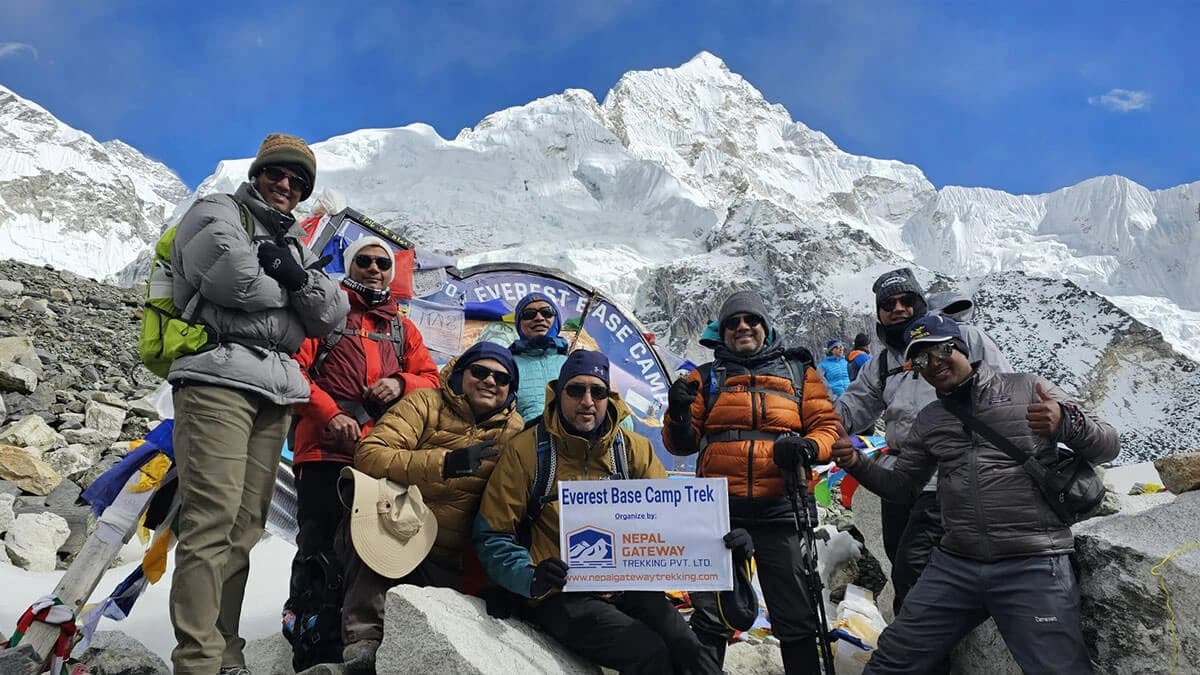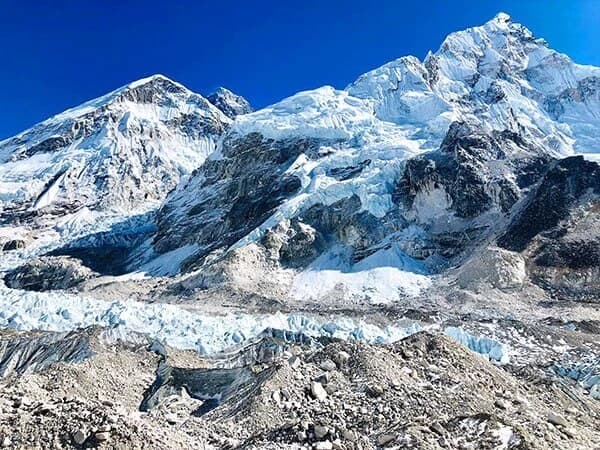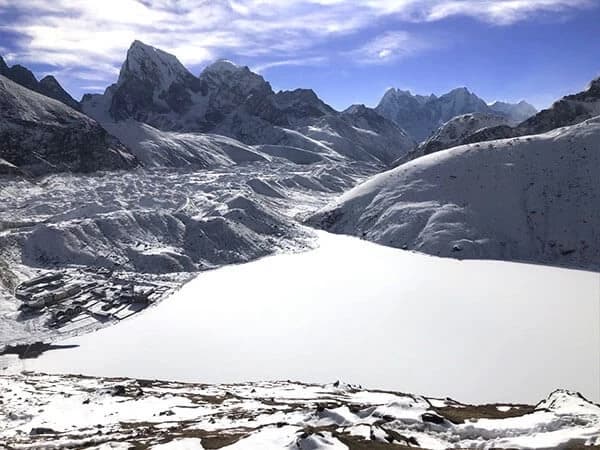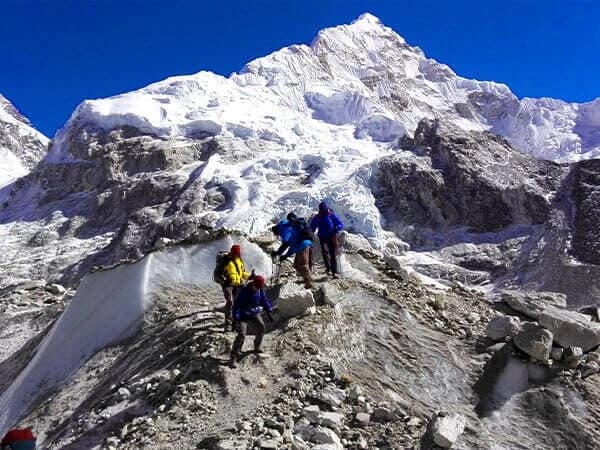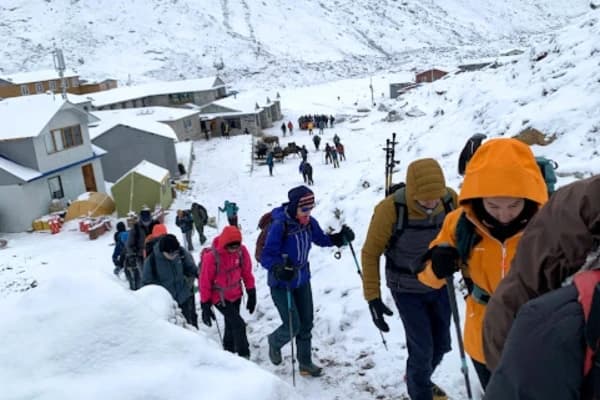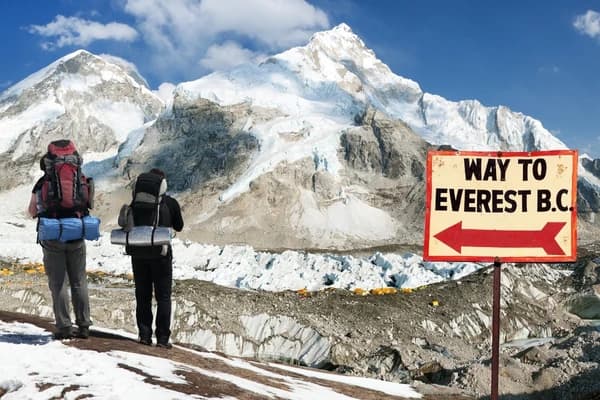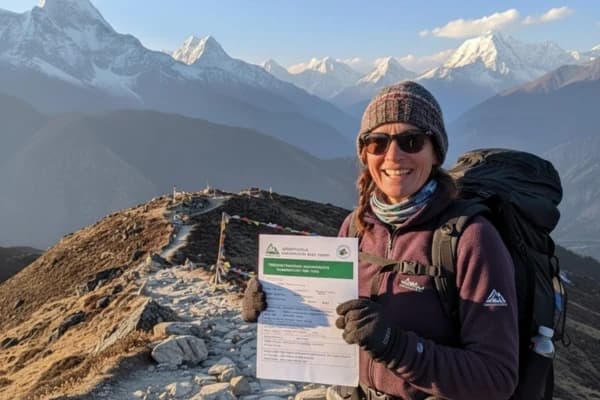The Everest Base Camp Trek is the most desired trekking trail in Nepal among the other trekking routes in Nepal. Everybody in the world wants to do this iconic EBC trek. It is on my bucket list, and I dream of being at the base camp of the highest mountain on earth. Trekking to Everest Base Camp is not an easy task.
How to prepare for Everest Base Camp Trekking
You need proper planning and a team to achieve your goal. In addition, you need to do home training to make your legs stronger and fitter. You have to work on your cardio to adjust to low oxygen as you gain elevation. You also have to work on building your strength.
Any trek ascending above 3,000 meters is classified as a high-altitude trek. These treks are renowned for their physical demands and the profound mental resilience they require. Despite the challenges, these treks offer a once-in-a-lifetime experience. The trekkers are rewarded with awe-inspiring vistas and a deep sense of accomplishment.
Trekking to Everest Base Camp
Trekking to Everest Base Camp is a journey that offers unparalleled adventure and awe-inspiring beauty. Nestled at the foot of the world's tallest peak, this trek takes you through diverse landscapes. Everest Base Camp Trek takes you from lush forests and roaring rivers to stark, high-altitude alpine meadows.
Along the way, you'll encounter the rich culture of the Sherpa people while visiting ancient monasteries. You will also witness the panoramic and incredible views of the highest mountains including Mount Everest. The physical challenges, combined with the serene beauty is something you never forget. Reaching at the base camp of Mount Everest is a once-in-a-lifetime experience.

Pre-Trek Preparations for Everest Base Camp: A High-Altitude Adventure
To begin with,
The Pre-Trek Routine
Embarking on a journey to Everest Base Camp isn't just a walk in the Sagarmatha National Park. It requires a well-thought-out and meticulous preparation plan. Before setting foot on those hallowed trails, it's crucial to establish a rigorous training regimen that ensures physical fitness.
The thrill of ascending to dizzying heights, where each step takes you closer to the heavens. The further away from abundant oxygen, demands a focus on building cardiovascular endurance.
The Heart of the Matter
In the lofty altitudes of the Himalayas, your heart becomes the hero and warrior, pushing harder against thin air. This paradox of needing more effort in an environment with less oxygen makes cardiovascular training indispensable. Incorporating exercises that elevate your heart rate and enhance stamina prepares you for the relentless ascents in high-altitude trekking. The stronger your cardiovascular endurance, the more you'll enjoy the journey, tackling steep climbs with greater ease and grace.
Strength in Every Step
The cardiovascular fitness is only half the battle. The rugged, unpredictable terrain of the Everest Base Camp trek also calls for robust muscular strength. Think of strength training as your armour, fortifying your legs, core, and upper body to power through uneven paths. Make yourself ready for rocky inclines and the various obstacles the trek throws at you.
Building muscular endurance ensures that you can navigate these challenges smoothly. It also helps reducing the risk of injury and enhancing overall trekking efficiency.
A Two-Month Countdown
For beginners, a comprehensive two-month training period is highly recommended to get into peak condition. This preparation phase is your blueprint for Everest Base Camp's success, focusing on both cardiovascular and strength training. By following a detailed guide, trekkers can assess their current fitness levels and systematically improve their endurance and strength. It will help themselves to embrace the breathtaking and breath-stealing landscapes of the Himalayas.
The Climb Ahead
Each training session is a step closer to standing in the shadow of Everest. Embrace the journey, build your stamina, and strengthen your resolve. With every heartbeat and every muscle fibre, prepare to conquer the mighty Everest Base Camp. As you ascend, remember that each effort made in preparation will translate into a smoother one.
It is necessary for more exhilarating adventure through some of the most awe-inspiring terrain on Earth. The mountains are calling, and with the right preparation, you'll be ready to answer. By investing time and effort into these crucial aspects of training, trekkers equip themselves. The well equipment needs to confidently conquer the majestic Himalayas and making the dream of reaching Everest Base Camp.
Now we done with the preparations. Let's get ready for the finale:
Undergo a Medical Checkup
Before you lace up hiking boots and head off on your epic journey to Everest Base Camp, it's time for a little TLC. TLC means a Thorough Life Checkup. As you wouldn't drive a car without checking the engine, you shouldn't tackle the mighty Himalayas without ensuring your body. Whether it's a minor glitch or a major malfunction, knowing your body's status is crucial.
Do you have a sneaky knee that acts up on stairs? Or maybe a heart that likes to beat to its drummer? Get it all checked out. And please don’t just keep this information to yourself. Share it with your trek buddies and guides.
If you suddenly need to pop a pill or take a break, they'll understand it’s not because you saw a Yeti but because you’re being smart about your health.
Establish an Appropriate Training Plan
Now, you are on to the entire training. Think of this as your Rocky montage; you're tackling something a bit grander—the steps to Everest Base Camp. The demands of trekking are no walk in the park; they’re more like a gruelling marathon with breathtaking views. So, you’ll need a regimen that’s tougher than old yak butter.
Start by getting your heart pumping. Cardio is king when it comes to prepping for high-altitude treks. Running, cycling, swimming—whatever gets your heart rate up and lungs burning. Next is time to pump some iron.
You can go to the gym. You don’t need to look like Mr Universe, but you have to have strong legs, a sturdy core, and resilient upper body muscles. The strong muscles will help you haul yourself and your gear over rocky paths and up steep ascents.
Priority on Acclimatize
After the 3,000 meters, give yourself a day or two to rest and let your body catch up with your ambitious spirit. You always have to remember the golden principle of altitude: climb high and sleep low. Limit your ascent not more than 500 meters per day to keep Acute Mountain Sickness (AMS) at bay.
This is not the time to channel your inner superhero; it’s about steady progress. After all, slow and steady not only wins the race but also enjoys the stunning scenery without gasping for breath. Like a fish out of water.
Proper Hydration Practices - The Key Factor
When navigating higher altitudes, the atmospheric conditions change, with the air becoming thinner and drier. The atmospheric shift not only triggers an increase in respiration rate due to reduced oxygen levels. It makes a results in a notable loss of body fluids. Experts recommend a daily water intake ranging from 3 to 4 liters.

The Fundamentals of Altitude Sickness
When venturing into the lofty heights of the Himalayas, your body goes through a series of noticeable changes. A mild headaches often serving as the first clue. However, it's crucial to familiarize yourself with the various stages of altitude sickness to mitigate potential risks. If you notice the altitude sickness, it also ensure a safe journey.
Understanding Acute Mountain Sickness (AMS)
AMS is a common ailment triggered by decreased oxygen levels at elevations above 2,800 meters. The symptoms of AMS include headaches, fatigue, insomnia, shortness of breath, and nausea. The most effective remedy for AMS is simple: acclimatization. Going slow and giving a time to your body to adjust with elevation and thin air, can help you avoid these unpleasant symptoms.
High Altitude Pulmonary Edema (HAPE)
Gaining more elevation with the mild altitude symptoms, you may encounter High Altitude Pulmonary Edema (HAPE). HAPE is a condition where fluid accumulates in the lungs, making it difficult to breathe. HAPE typically strikes at altitudes above 3,000 m and presents symptoms like shortness of breath at rest. You feel extreme fatigue, a dry or wet cough with frothy sputum, and fever.
Ignoring HAPE is not an option; it demands immediate descent to lower altitudes. You may have to fly with the helicopter to get prompt medical attention to prevent serious consequences.
High Altitude Cerebral Edema (HACE)
High Altitude Cerebral Edema is a condition where excess fluid accumulates in the brain, leading to altered mental states. The major sings are coordination difficulties, hallucinations, unconsciousness, confusion, and lethargy. HACE is a medical emergency requiring urgent evacuation and professional medical intervention.
Slow and Steady Pace
In the high-stakes game of altitude trekking, it’s best to channel your inner tortoise. We all know that slow and steady truly wins the race. Pushing yourself to the limit is good, but it significantly increases the likelihood of encountering altitude sickness.
You can save energy and give your body to adapt to the altitude by maintaining a careful pace. It will ensure a safe and more enjoyable journey.
Investigating Food Options
Fueling your body correctly is paramount during a high-altitude trek like the Everest Base Camp Trek. The physical demands are immense, and your diet needs to match the challenge. Foods rich in carbohydrates, along with adequate protein and fat, provide the necessary energy. A higher caloric intake aids your body in acclimating to the altitude while keeping your energy levels high.
Before setting off, research the available food options on the trail. You may consider carrying energy bars and nuts for quick, instant energy boosts.
Appropriate Attire Selection
Embarking on high-altitude trekking necessitates meticulous preparation, with the thoughtful selection of appropriate clothing being a crucial aspect. Striking a delicate balance between too little and too much is imperative for a comfortable and successful trek.
The Base Layer
As you navigate through high-altitude terrain, the significance of a well-considered base layer becomes paramount. This typically includes a shirt, undergarments, and socks. The base layer's role is to regulate body temperature. Choosing breathable, non-itchy fabrics can significantly enhance your comfort, ensuring a more enjoyable trekking experience.
The Mid-Layer
Moving beyond the base layer, the mid-layer is very important for the high-altitude trek. A light fleece jacket is a practical choice, especially during the more incredible morning hours and while taking breaks. Fleece is known for its breathability, warmth, and quick drying.
For an extra layer of warmth, consider down-insulated jacket. Down jacket is easy to pack, highly compressible, and provide superior insulation. It ensuring you stay warm in the chillier segments of your high-altitude journey.
The Outer Layer
Water-resistant and breathable shells are blessings in the challenging conditions of high altitudes as the outer layer. Designed to withstand drizzle, wind, and various weather conditions, these shells add an extra layer of protection. Investing in quality gear for the outer layer is essential. Durability is key for prolonged and effective use in demanding environments.
Investing in Quality Gear for an Optimal Trekking Experience
When it comes to trekking, the significance of quality gear cannot be overstated, especially in higher altitudes. Opting for branded bags and boots is not just a matter of style but a practical choice ensuring reliability. Proper sizing of both bags and boots is critical. Moreover, carrying only essential gear minimizes unnecessary weight and maximizes efficiency.
The Importance of Good Boots
A well-fitted pair of boots is crucial, as they are the only gear you'll wear for extended hours. Investing in a quality pair is essential for the comfort and well-being of your feet. Adding an extra pair of supportive insoles enhances overall support and comfort, especially during prolonged treks. Waterproof boots are valuable at higher elevations, where sudden changes and encounters with snow are common.
Packing Essentials
While it's essential to carry all necessary gear, investing in branded and sometimes expensive articles ensures reliability and durability in demanding conditions. Trustworthy gear built for such terrains can make a substantial difference in your overall trekking experience.
In conclusion, preparing for a high-altitude trek involves a combination of understanding altitude sicknessand maintaining a steady pace. Beside these investigating food options, selecting appropriate attire, and investing in quality gear are helpful too. With these you enhance your ability to enjoy a safe and memorable trek through the majestic high-altitude landscapes.
Understanding the Terrain
Knowing and preparing accordingly the steep inclines, rocky paths, or slippery slopes allows you to success the trip. You do not get panic and disappoint with the terrain which makes your trip wonderful and enjoyable.
Choose the Best Season
Timing is everything, especially when it comes to trekking. Picking the right season for your adventure is like choosing the right playlist for a long road trip. Choosing the right time is the tone for the entire journey. Doing your homework on the local weather conditions and seasonal changes can make all the difference.
Autumn and Spring are the best seasons to visit Nepal for Everest Base Camp Trek. Autumn boasts clear skies and crisp air perfect for stunning views, spring gifts you with blooming flowers and longer daylight hours. Your personal preference and desired experience will guide you to the ideal time for your trek.
Pro-Tip: Trek with the Pros
If you're serious about trekking to Everest Base Camp, then consider going with professional companies and guides. Trekking to EBC with experienced guides adds an extra layer of security and expertise to your journey. They have years of experience in high-altitude trekking, understand the associated risks, and know how to manage them. They’re like walking encyclopedias of the mountains, providing invaluable assistance, both mentally and physically, ensuring a more secure and enjoyable trekking experience.
Ensuring Comprehensive Coverage with Insurance
Before you embark Everest Base Camp Trekking, make sure that your travel insurance covers evacuation if needed. If you need to stay at the hospital due to AMS, make sure it covers too. The helicopter and hospital expenses are very costly. Beside these, you can ask your insurance to covers for trip cancellation and any loss or damage with your belongings.
Anticipate the Adventure with Enthusiasm
Approach your trek planning with the same enthusiasm you’d have for planning a dream vacation. This is your chance to leave behind any lingering worries from home and embark on a journey of self-discovery. As you anticipate the adventure ahead, balance your excitement with careful consideration of safety measures, including comprehensive insurance. This way, you can enjoy the thrill of the trek with peace of mind, knowing you’re well-prepared for whatever challenges lie ahead.
Conclusion
You need to understanding the landscapes and choosing the best season for enjoyable EBC Trek. Trekking with professionals, ensuring comprehensive insurance coverage, and anticipating the adventure with enthusiasm are all key steps to a successful and enjoyable trekking experience. So, gear up, do your homework, and get ready to make unforgettable memories of the line in the great Himalayas.
Summary
Preparing for Everest Base Camp is like preparing for the adventure of a lifetime. So, do not hesitate to research everything you need to know before embarking on your journey to Mount Everest Base Camp.
